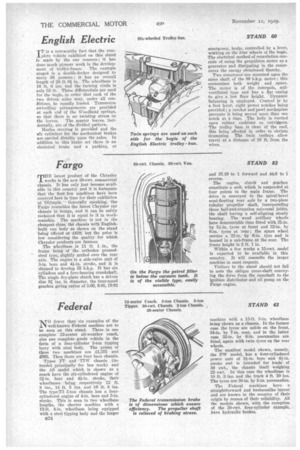English Electric
Page 162

If you've noticed an error in this article please click here to report it so we can fix it.
I T is a noteworthy fact that the complete vehicle exhibited on this stand is made by the one concern ; it has done much pioneer work in the develop ment of trolley-buses: The example staged is a double-decker designed to carry 56 persons; it has an overall length of 23 ft. 01 in. The wheelbase is 16 ft. 6 ins, and the turning circle is only 55 ft. Three differentials are used for the bogie, in order that each of the two driven axles may, under all conditions, be equally loaded. Transverse swivelling arrangements are provided at each end of the Woodhead springs, so that there is no twisting stress on
the leaves. The master leaves, incidentally, are of the divided pattern.
Whiles steering is provided and the air cylinders for the mechanical brakes are carried directly upon the axles. In addition to this brake set there is an electrical brake and a parking, or emergency, brake, controlled by a lever, scenting on the four wheels of the bogie. The electrical method of retardation consists of using the propulsion motor as a generator and dissipating in the resistances the energy occasioned thereby.
Two armatures aremounted upon the same shaft of the 80 b.h.p. motor ; this economizes both weight and space. The motor is of the interpole, selfventilated type and has a flat casing to give a low floor height. 'Dynamic balancing is employed. Control is by a foot lever, eight power notches being provided ; a ratchet and bawl mechanism prevents it being moved more than one notch at a time. . The body is carried upon rubber cushions on outriggers. The trolley base is clear of the roof, this being effected in order to 'obviate drumming. The twin trolleys allow travel at a distance of 16 ft. from the wires.








































































































































































































































































































































